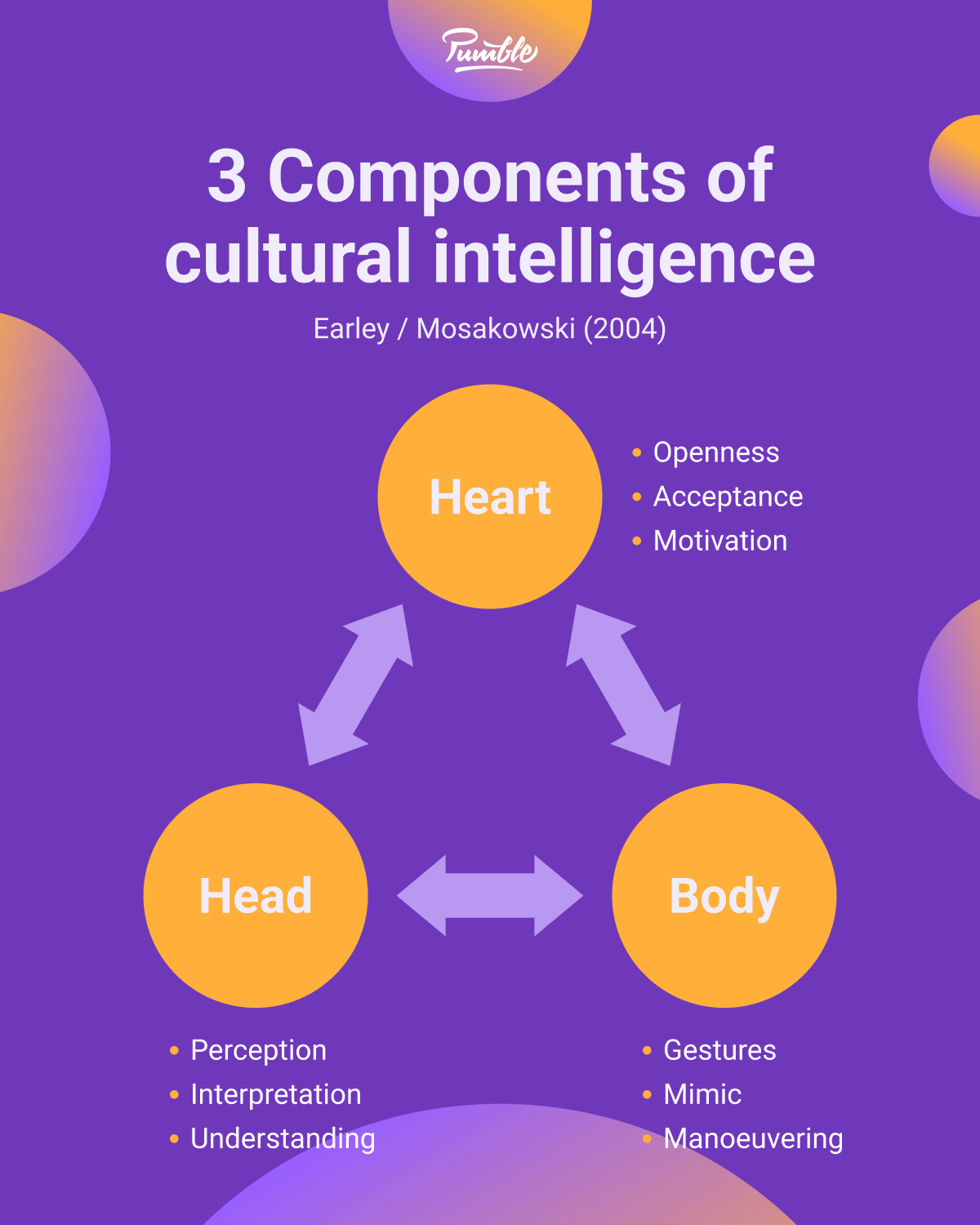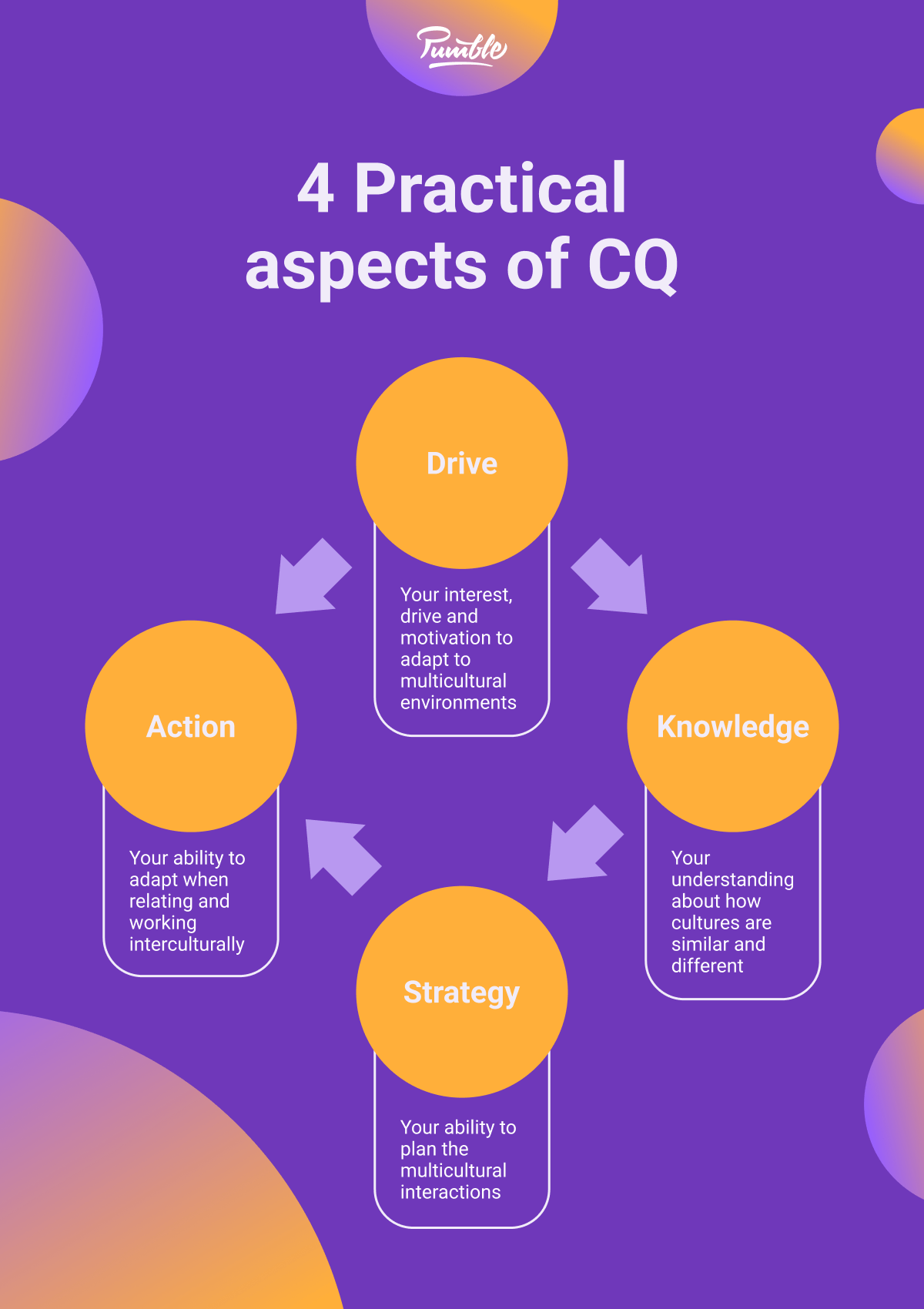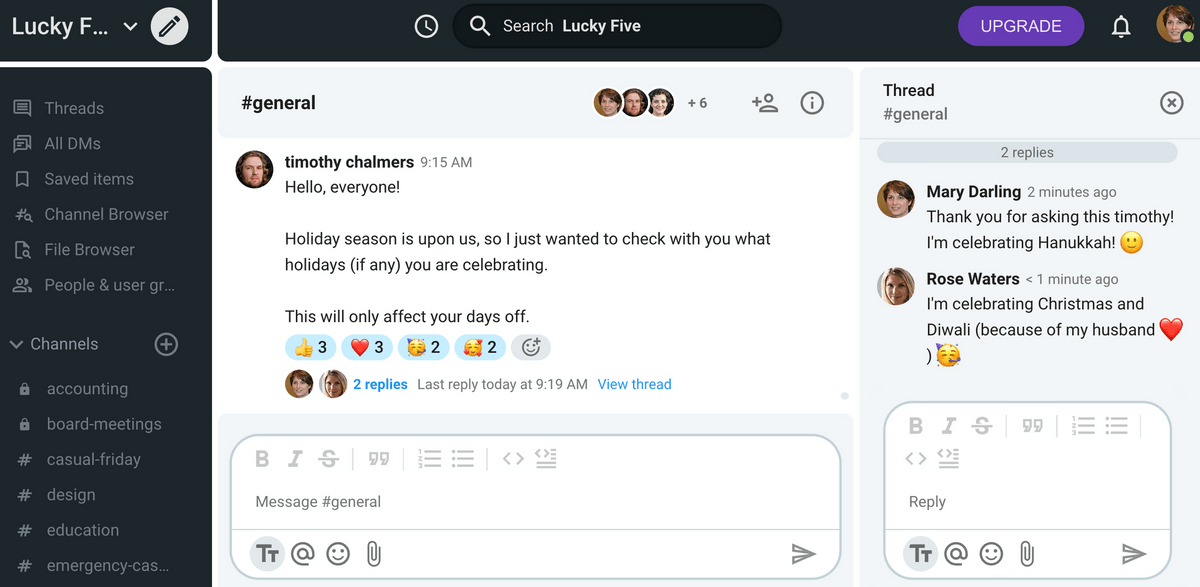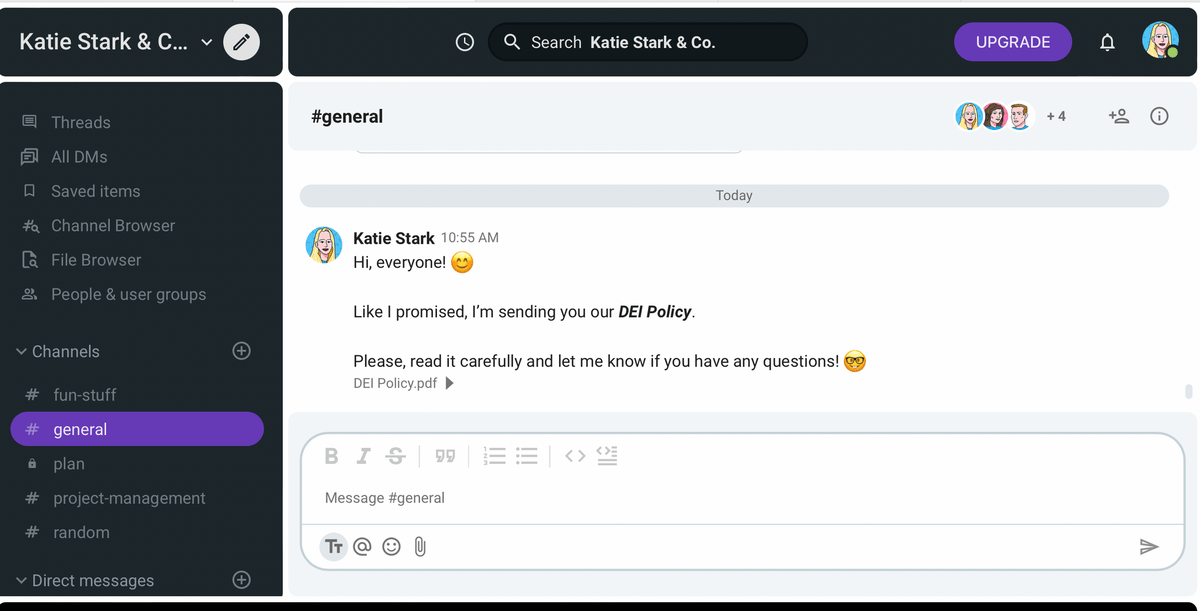In the modern workplace, having a high IQ and EQ is not a guarantee for success anymore.
Because of the increasingly globalized, multicultural, and diverse workforce, there’s another factor we should consider.
Namely, we have to learn to work effectively with people from around the world and with different backgrounds.
That’s where cultural intelligence comes in. It helps us adapt to the global workforce. Sometimes, we notice our shortcomings only when we come into contact with a new challenge.
Luckily for us, issues stemming from low cultural intelligence are not unsolvable, as cultural intelligence can be improved.
This blog post will help you achieve that, as we’ll cover:
- What cultural intelligence is,
- Why it’s important, and
- How to improve cultural intelligence, both on individual and organizational levels.
Let’s dive in!

Table of Contents
What is cultural intelligence?
Cultural intelligence, or CQ (Cultural Quotient), is our ability to effectively adjust to new cultural contexts and different cultures.
In their book Cultural Intelligence: Individual Interactions Across Cultures, P. Christopher Earley and Soon Ang define cultural intelligence as “a person’s capability for successful adaptation to new cultural settings, that is, for unfamiliar settings attributable to cultural context.”
Simply put, in workplace environments, cultural intelligence refers to our capability to work effectively with people from different cultural backgrounds.
This ability is not limited to our cultural sensitivity and awareness but goes beyond that. Namely, people with high cultural intelligence feel confident in new environments and, by making informed judgments based on observations, they are able to use their skills to realize their objectives in culturally diverse situations.
The difference between emotional and cultural intelligence
According to psychologist Daniel Goleman, the author of the book Emotional Intelligence: Why It Can Matter More Than IQ, cultural and emotional intelligence share one crucial element — a tendency to think before acting.
However, here’s the main difference. Emotional intelligence refers to our capacity to understand our own and others’ feelings, whereas cultural intelligence deals with our ability to grasp cultural aspects of other people’s behavior, values, and attitudes.
Namely, people with high emotional intelligence are quick to pick up on other people’s emotions, wants, and needs. Moreover, they understand how their behavior and emotions affect others. In other words, they are empathetic and perceptive. However, they sometimes lack the skills to understand the cultural factors involved and adjust their behavior accordingly.
On the other hand, aside from being aware of people’s feelings and needs, those with high cultural intelligence notice peculiarities in the values, beliefs, and attitudes of people from different cultures. They are, therefore, able to adapt their behavior to the circumstances.
To put it another way, they are highly empathetic and perceptive even when they communicate with people who come from other cultures and behave in ways they’re not so familiar with.
3 Components of cultural intelligence
In their HBR article Cultural Intelligence, P. Christopher Earley and Elaine Mosakowski state that cultural intelligence consists of 3 components:
- Cognitive skills (Head), which include:
- Perception,
- Interpretation, and
- Understanding of cultural differences.
- Physical cues (Body), where we need to pay attention to:
- Gestures,
- Mimic, and
- Manoeuvering.
- Emotional understanding (Heart), which implies:
- Openness,
- Acceptance, and
- Motivation.

So, to understand this phenomenon and improve our own cultural intelligence, let’s take a closer look at each of its components.
Component #1: Cognitive skills — Head
The first component of cultural intelligence, cognitive skills, is dubbed the Head.
It deals with our ability to understand a different culture and adapt our behavior in ways that will streamline our communication with the members of the said culture and eradicate some of the most common communication barriers.
This also means that our cognitive skills can help us better understand different cultures, by doing some research and showing an active interest in our colleagues with different backgrounds.
For instance, let’s say your company has sent you to another country to manage a department. The first thing you need to do is carefully study the culture of the country and try to understand the locals’ behavior. This is the first step to you being a successful manager both in your country and the new one you’ve been sent to.
Overcome communication barriers with Pumble
💡 PUMBLE PRO TIP
Understanding different cultures is by no means an easy task. It requires you to successfully cross any obstacles that stand in the way. So, if you need any help with cross-cultural communication, read our blog post on that topic:
Component #2: Physical cues — Body
The next component of cultural intelligence is the Body, aka the physical cues.
Namely, this part refers to our ability to notice how different cultures use physical cues and reciprocate them. By doing this, we’re showing our coworkers that we’re making a conscious effort to understand their culture and ensure we don’t offend them inadvertently.
It’s not enough to say you understand the culture of your foreign colleagues or guests. You need to show them you understand it — with your actions and behavior.
For example, an American professional meeting with a French colleague in Paris might be confused by being greeted with two pecks on the cheeks. While kissing a business associate is perfectly acceptable in France, it’s completely inappropriate in the US.
Component #3: Emotional understanding — Heart
The third component of cultural intelligence is emotional understanding, the Heart. In other words, this is the part where motivation for understanding colleagues from different cultures and successfully collaborating with them is key.
This means that, when adapting to new cultures, we’re almost certainly going to face challenges and setbacks. The main part is to persevere and don’t let ourselves get discouraged by mistakes we make in the learning process.
That’s where motivation comes in. It allows us to recuperate after facing obstacles or failure and try again. We need to learn from our mistakes and be determined to make more effort to efficiently communicate with our colleagues from different cultures.
For example, let’s say we have never worked with colleagues from other cultures before, and now all that has changed as our company opened offices in Spain. There are bound to be some problems — maybe just tiny miscommunication issues — but it’s up to us to muster the courage to continue with our efforts even when we face challenges.
Why is cultural intelligence in the workplace important?
Now that we’ve become more acquainted with cultural intelligence and its components, it’s time to consider its importance in the workplace.
In search of answers, we have reached out to a number of experts, so let’s see what they had to say about the benefits of cultural intelligence in the workplace.
Benefit #1: Cultural intelligence improves communication and collaboration
Undoubtedly, one of the main benefits of cultural intelligence is improved communication and, consequently, collaboration. This is precisely what our contributor Ryan C. Warner, Ph.D., Clinical Psychologist and Founder and Chief Executive Officer at RC Warner Consulting, LLC, told us:

“Cultural intelligence in the workplace is vital as it fosters understanding and collaboration among diverse teams. It enables effective communication, respect for varying viewpoints, and enhances innovation by drawing from a rich tapestry of perspectives.”
Moreover, as Judy Ravin, Linguist and Co-Founder at Accents International, highlights, cultural intelligence is significant for forming partnerships:

“Cultural intelligence allows for partnership. Without it, ideas don’t get shared, and problems don’t get solved. It’s not only a nice thing, but also a business imperative. Cultural intelligence leverages innovative ideas that come with a diverse talent base. It allows all voices to contribute with impact. Without it, businesses are at a competitive disadvantage.”
Benefit #2: Cultural intelligence improves workplace environment
Having a positive work environment is one of the most essential conditions for employee satisfaction, and — hate to break it to you — this doesn’t mean a foosball table and lazy bags.
Namely, in the age of increased awareness of DEI, cultural intelligence is certainly a factor in creating a positive workplace atmosphere. Diversity, a “tapestry of perspectives”, as Ryan C. Warner called it, makes the workplace environment more enjoyable. However, it doesn’t mean much without cultural intelligence, as Nikki Innocent, Holistic Coach for Career, Life and Interpersonal Change, points out:

“CQ is vital in building a foundation of inclusion for an organization. This allows for diversity to prosper, which results in higher levels of innovation, better returns, and lower financial risk. Creating a workplace where diverse perspectives are celebrated also results in a workforce with more dynamic interpersonal conflict resolution skills, deeper levels of trust, and stronger resilience in times of uncertainty.”
💡 PUMBLE PRO TIP
To learn more about diversity, equity, and inclusion in the workplace, read our blog post on this topic:
Benefit #3: Cultural intelligence widens the talent pool
Another benefit of cultural intelligence is that it allows companies to recruit the best talent from all around the world.
By working on improving cultural intelligence within their workforce, companies are not limited to hiring only domestic candidates but can choose from a much larger talent pool.
Having employees with high CQ enables the companies to have a more collaborative workforce.
Moreover, a cross-cultural workforce helps companies compete within the global market, as it enables more effective partnerships and collaborations outside of the local market.
Benefit #4: Cultural intelligence increases employee retention
Furthermore, CQ is one of the key factors in increasing employee retention, as Dr. Tonicia Freeman-Foster, National Trainer, Consultant, and Leadership Coach, points out:

“Cultural intelligence in the workplace is important for reducing assimilation and increasing employee retention. Employees are human beings first. Innovation and teamwork thrive when employees feel a sense of belonging as their authentic selves and in their own skin. Cultural diversity should be celebrated, but knowing it is the only way to embrace it fully.”
Working in an environment where diversity is celebrated and employees have high CQ allows everyone to feel comfortable in their own skin. This is precisely why they’re motivated to stay in the company longer.
Try Pumble and see the teamwork thrive
Benefit #5: Cultural intelligence decreases employee burnout
Lastly, Nikki Innocent points out that cultural intelligence may help curb employee burnout:

“Investing in CQ can foster a sense of belonging, which helps thwart issues of employee burnout (a recent Harvard study finds annual healthcare spending due to workplace burnout is anywhere from $125 billion to $190 billion) and employee turnover (which is estimated to cost between half to 3 times an employee’s salary).”
Again, the sense of belonging people feel when working with colleagues with high CQ helps them feel psychologically safe in the workplace. This, in turn, leads to lower rates of burnout.
💡 PUMBLE PRO TIP
If you’re interested to learn more about mental health in the workplace, we have just the right article for you:
—
Now that we’ve covered the main benefits of cultural intelligence in the workplace, it’s time to give you some tips on how to improve it — both on an individual and organizational level.
How to improve the 4 practical aspects of cultural intelligence
As different studies show, culturally diverse teams are more innovative and logical than homogeneous teams.
That’s why it’s more important than ever to work on improving our cultural intelligence so that we can better function in cross-cultural teams.
According to Dr. David Livermore, there are 4 practical aspects of cultural intelligence, as he highlights in his book The Cultural Intelligence Difference:
- CQ Drive — Your interest, drive, and motivation to adapt to multicultural environments,
- CQ Knowledge — Your understanding about the differences and similarities among cultures,
- CQ Strategy — Your ability to plan multicultural actions, and
- CQ Action — Your ability to adapt when working interculturally.

To improve our cultural intelligence quotient (CQ), we should work on developing all 4 of these aspects.
So, here are our tips on how you can do that.
Tip #1: Improve your CQ drive
The first practical aspect of cultural intelligence you need to improve is your CQ drive.
This refers to your motivation to learn about a different culture.
If you’re not familiar with the culture your colleagues belong to, chances are you’re not going to adapt well to it.
So, this drive is the first step towards higher cultural intelligence that may help you open up to new possibilities.
All you have to do is explore the new situation you find yourself in.
To successfully motivate yourself to immerse yourself in a new culture, you can:
- Get acquainted with people from different social backgrounds and communities — This gives you the opportunity to understand your cross-cultural colleagues better.
- Learn a new language — Aside from acquiring a new skill, you’ll learn a lot about the culture in question. After all, according to the Sapir-Whorf Hypothesis, “the particular language one speaks influences the way one thinks about reality.”
- Involve yourself in projects that allow you to get to know people from different cultures — This is a perfect way to learn first-hand something more about the customs and behaviors of a new culture.
- Read about different cultures — If all of the above is too much for you, you can always read about different cultures. Choose a well-known author from the culture your colleague comes from and read a novel. This will certainly motivate you to try to get to know your cross-cultural colleagues better.
All of the above might push you to go further into this adventure of getting to know other cultures.
Practice cultural intelligence over Pumble
Tip #2: Widen your CQ knowledge
After you’ve motivated yourself to get a bit more familiar with other cultures, it’s time to go one step further and widen your CQ knowledge.
Of course, this doesn’t mean you need to become an expert in the said culture. Simply, you should strive to get to know the ways in which that culture forms and influences its people’s values, beliefs, and behaviors.
To become more attuned to the culture’s influence on people’s behaviors, you need to actively listen to your colleagues, as Dr. Warner suggests:

“To improve cultural intelligence, engage in active listening to genuinely comprehend others’ experiences, values, and norms. Seek out diverse experiences, read about different cultures, and embrace discomfort to broaden your perspective. Reflect on your assumptions, and be open to learning.”
To better understand different cultures, Nikki Innocent suggests that you embrace your curiosity — starting from your own cultural makeup:

“Instead of viewing this work as a test to ace, frame it as a journey of discovery and understanding without judgment. We grow up learning by memorizing the ‘right answer’ but the thing about CQ is you will be learning a variety of things that are all ‘right’ and true at once while they may differ.”
This approach may help you keep an open mind and widen your horizons, as she elaborates:

“One of the biggest hurdles in this process is a tendency towards hierarchy or comparison/competition rather than understanding. As you learn about other cultures, it doesn’t mean you must agree or abide by what you learn, it’s a matter of accepting that there are alternative paths others take.”
In other words, embrace diversity and enjoy it!
Tip #3: Develop a CQ strategy
Next, you need to use what you have learned and come up with a strategy that will help you boost your CQ.
This entails some steps you can take to make it easier for you to nurture the culturally aware type of behavior.
Step #1: Challenge your unconscious biases
To be able to disrupt your unconscious biases, first, you need to understand where they come from.
Namely, unconscious biases are usually a product of the way we are socialized. Most often, we unconsciously internalize and accept the beliefs of the people from our immediate surroundings.
Moreover, unconscious biases can be a direct result of the situations we’re familiar with — as our brain uses our previous experiences to make shortcuts in thinking.
However, if we make a conscious effort to challenge our unconscious biases, we won’t take anything for granted. We’ll pause and think before we interact with people from other cultures, thereby minimizing the chances of saying something insensitive.
💡 PUMBLE PRO TIP
If you want to learn more about unconscious biases in the workplace and the ways to combat them, read the following blog post on that topic:
Step #2: Expose yourself to various media
This is a useful and easily accessible way to learn about how culture affects our behavior.
Read different newspapers and watch TV shows and movies about cultures you’re not so familiar with, to make yourself accustomed to different ways of thinking and behaving.
Again, it helps if you learn the language of the culture you’re interested in, as we’ve mentioned before. This may open a whole new world to you, and it can help you better understand your colleagues from other cultures.
Step #3: Write about your cross-cultural journey
It also helps if you keep a journal of your cultural observations.
Make notes any time you’ve successfully deciphered the behavior of a colleague from a different culture. Also, don’t forget to record your failures to do so, as well as the frustrations that come with them.
This practice can help you become more aware of your cultural biases and assumptions, which is a prerequisite for conquering them.
Tip #4: Engage in CQ action
Lastly, you should engage in CQ action, by paying attention to your behavior, both when things go as you planned and when they go wrong.
So, when something doesn’t go according to your plan, don’t worry. If you have done all the necessary research about the business etiquette concerning the culture you’re working with, you’ll know what to say.
Even if you face problems or miscommunication, you have to be prepared to think quickly. The safest bet is to ask questions when you don’t understand something. People usually don’t get offended when you try to clear things out. On the contrary, they will probably appreciate your interest in their culture. Also, don’t forget to apologize to your colleagues if you have misunderstood them.
💡 PUMBLE PRO TIP
When working in cross-cultural teams, sometimes you might inadvertently insult your coworkers. These unintentional subtle insults are called microaggressions, and, luckily for you, we have a whole blog post dedicated to this topic, if you want to broaden your horizons:
How to encourage cultural intelligence within a company
To really make a difference in cross-cultural communication, you need to take your organizational communication up a notch.
One of the ways to do that is by encouraging cultural intelligence within a company.
The experts we’ve contacted gave us some useful advice on how to do just that, so let’s see what they had to say.
Tip #1: Celebrate differences
The first thing you should do is celebrate diversity within your company, as Dr. Tonicia Freeman-Foster advises:

“To improve cultural intelligence, organizational leaders must first cultivate a culture where differences are welcomed, encouraged, accepted, and honored.
In addition to staff demographics, cultural diversity should be visible on the company’s website, newsletter, brochures, wall art, language used on documents, and more.”
This also means that you should keep these differences in mind during the holiday season and not assume everyone celebrates the same holiday. It’s best illustrated in the Pumble example below, where Timothy Chalmers, Head of HR, is explicitly asking his colleagues what holidays they are celebrating.

Use Pumble to celebrate the differences in your team
Moreover, to make sure you understand your coworkers from different parts of the world, you should hone your comprehension skills, as Judy Ravin suggests:

“In a workforce where employees come from all corners of the world, one thing to do is teach people how to understand the diverse accents of their colleagues.”
Tip #2: Learn more about different cultures
Leadership & Empowerment Expert, Ashley T Brundage, underscores that the best way to increase cultural intelligence is to communicate culturally different information in a mainstream way for all of your employees, to enable them to learn about different cultures:

“Several organizations I work with hold cultural days of celebration and other history and heritage month programs, but our research shows us these are more impactful as broad leadership opportunities for all people to attend in the organization. This will drive more attendance for these learning opportunities and make them less polarizing for all the cultural differences we have as people.”
Similarly, Dr. Tonicia Freeman-Foster suggests including activities that help you get to know other cultures in everyday workplace activities:

“Companies can easily encourage cultural intelligence during team meetings and activities. Most people love good music and good food. There are ways to incorporate cultural intelligence in these activities through storytelling and sharing traditions, experiences, symbols, and artifacts.”
A surefire way to get yourself acquainted with different cultures is by listening, as Nikki Innocent proposes:

“Do a listening tour. These can be live conversations with people across the organization in select interviews across roles, levels, and regions, or in a more anonymous setting like a submission box or survey.
Whatever method you choose, you’re offering an opportunity to hear the real experiences of your colleagues without fear of retribution or repercussion. It is an incredibly powerful way to understand the hurdles to CQ that currently exist while shining a light on the areas where CQ work would make the most impact to focus on.”
Tip #3: Make an effective DEI plan
Dr. Ryan C. Warner has a piece of advice on how to encourage cultural intelligence within an organization. He advocates that you should promote a safe environment for everyone to share their cultural backgrounds and provide them with strategies for overcoming any cultural barriers:

“Incorporate effective DEIB training, cross-cultural mentorship, and diverse project teams. Create platforms for employees to share cultural insights, fostering a culture of inclusion and understanding.”
However, Ashley T Brundage adds that you should not make cultural differences about the marginalized communities, as you won’t impact the whole organization. Instead, she suggests you include the whole workforce:

“Work to create communication and messaging that drives a message of leadership opportunities to learn for all people and loop in your corporate executives to have an active role in the program.”
In the Pumble example below, Katie Stark is sharing a DEI policy with her coworkers.

Send updates and share files on Pumble
Tip #4: Get leadership involved as CQ advocates
Successful boost of cultural intelligence within a team depends on the role a leader takes, as Nikki Innocent notices:

“Tap leaders within the organization who are willing to share their CQ journey, not as a ‘do it my way’ but as a reflection that investing in your own CQ is what a successful leader does.
It’s not a weakness but a strength to be curious and to continue to learn and evolve. This can be as simple as folding in storytelling elements in all-staff meetings whether as official agenda items or encouraging more storytelling throughout leadership communications.”
By setting an example, leaders can motivate their team to make an effort to improve their own cultural intelligence.
Tip #5: Amplify and reward CQ efforts
Lastly, after leading by example, managers should reward any CQ efforts they notice with their employees, as Nikki Innocent suggests:

“Depending on your style, you can highlight stories, offer leadership opportunities, grant compensation/performance benefits, or share case studies of employees across roles/level/region/tenure who experience the impact of their CQ work.”
This might motivate other employees to go the extra mile in boosting their cultural intelligence.
Pumble fosters understanding and collaboration among diverse teams
Pumble is a perfect place for cross-cultural communication because it has various features that help better collaboration between colleagues coming from different cultural backgrounds.
If you’re collaborating with outside partners, you can make them feel at home by giving them guest access and permission to access your Pumble workspace.
Furthermore, to encourage your teams to engage in creating a more positive environment ensure cultural intelligence is encouraged.
For example, Pumble lets you be mindful and respectful of teams working in different time zones as well as different national and cultural holidays.
Thanks to the availability status feature in Pumble, you can always reach out to your colleagues confidently without worrying you’re interrupting them.

When you see your colleagues’ statuses you will know if they are OOO, on a break, or a vacation.
Finally, to be a better DEI advocate, you can organize proper training via audio and video calls in Pumble to help your team learn more about different cultures and actively celebrate diversity.









